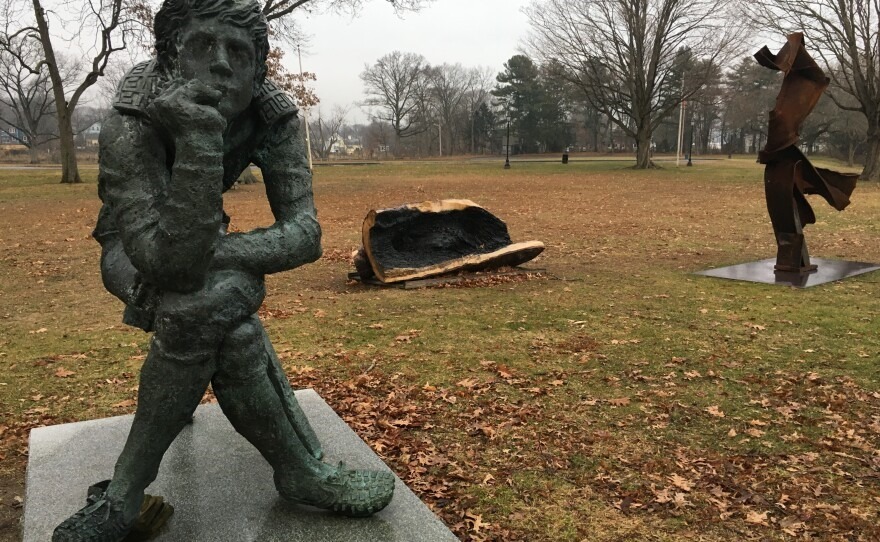October 4th Part IV
Task Force Panel: Mayor Laura Hoydick; John Casey, Town Engineer; Jim Benson, Chair of the Economic Development Committee; Mary Dean, Director Economic Development; Chris Tymniak, Chief Administrative Officer; Tom Dillon; George Perham, Principal, President at VIA Visionary Interiors Architecture
Editor’s Note: The S/L/A/M Collaborative Team, unlike previous presenters, had a whiteboard with QR codes, some of them were 3D videos, so that the Task Force Panel was able to scan on their phone. SLAM thought that would be helpful just to quickly get their skill sets out and present their executive summary of The Proposal. These QR codes were not visible to those in the audience.
Team # 4 The S/L/A/M Collaborative (SLAM)
SLAM is an architecture firm with integrated construction services, landscape architecture, structural and civil engineering, and interior design. We have an infinite drive to unlock and solve complex design problems. We strive to design exceptional places that inspire the people who inhabit them. Our design thinkers have a never-ending flow of ideas and energy across our offices in Atlanta, GA, Boston, MA, Denver, CO, Glastonbury, CT, Iowa City, IA, Los Angeles, CA, Orlando, FL, Philadelphia, PA, and Providence, RI. In short, we’re built around the exact services our clients need to take a building project from concept to completion, and to do it beautifully.
Our clients make the world a better place. At SLAM we create the places that make them smarter and more successful.
Team:
Daniel Granis, out of the Connecticut office in Glastonbury, is Principal/Landscape architect, and designs and manages an array of project types including recreational facilities, educational facilities, comprehensive master planning, town planning, and site planning. He has experience in all phases of a project, from site analysis and regulatory compliance through conceptual design, design development, construction documents, and contract administration.
Chuck Koichi, professional civil engineer.
Ryan Bond of Tighe&Bone, splits his time between the Middletown and Shelton offices. We probably have close to sixty engineering professionals, so pretty much all the services you can think of, we have right here in Connecticut, and I’ve been working in the Land Development field for some thirty years.
Jeff Gant I am a principal in the education Studio at SLAM, and I have been working in education projects for over twenty years. We deal a lot of times with campuses, and so understanding the way in which open space and buildings work together seamlessly is really important to us.
Alex Bagnall is from CavanaughTocci Associates. He is a principal consultant specializing in the area of theater planning, audiovisual, lighting and rigging system design. His projects typically involve design consulting and system layout using Revit, CAD and loudspeaker modeling software. Typical projects include performing arts and theater spaces, courthouses, athletic facilities, and classrooms.
Presentation Introduction:
The SLAM Collaborative is something that we take very seriously, with a focus in landscape architecture and planning, but we’re pretty much interchangeable working together, as we find if you design things from the inside out and the outside in at the same time, that’s how we make places. We’re not just building buildings—every project changes a place, not just with the project itself but everything around it. It’s like a stone thrown in water—it doesn’t just affect where it lands, but those ripples done properly have a dramatic impact on the community as a whole, so we take that very seriously. On the engineering front, as you know, Ryan Bond has all the pieces that we don’t have, so when you put the two together, it’s a one plus one equals three.
Timing and all of those things will be managed. We do have an in-house Construction Services team, so we are builders, as Dan mentioned. We have professional estimators on our staff, and we have an understanding of each other. There’s a Synergy where we can build this project, we don’t have to build this project, but either way it’s great to have that perspective of the marketplace, materiality procurement, all of those things are CR critical these days, and so having those folks in-house that we can walk over to their desk and ask a question is important. We understand the full spectrum of those stewardships, and understanding that you know all the different phases that they’ll be involved with, understanding the different costs that are associated with any project, so it’s critical that we have those in our in our team.
SLAM Presentation Highlights:
- Commitment to sustainability as it relates to flooding and to storm wage management for that is critical.
- Civil engineering, geotechnical will be important on this site. We have a coastal practice, and seeing as this is on the Housatonic river, there’s features to this that I think Coastal is going to be critical to this site.
- Soil remediation and hazardous building materials.
- Wastewater Building Services
- Make it a place making and not just a park and a blackbox theater.
- Our work is about our clients. We never say you should do this or you should do that. We want to listen to you find out what’s best for you, and our programmers will be heavily involved in figuring out what you really need, and then what you want, and we want to get you what you want as well, but we’re going to help prioritize those items
- We want it to be a transformational experience: what really excites us and draws our attention to your particular site and your particular program is there is lots of indoor-outdoor connection. The image with the amphitheater with the waterfront view — we want to make sure it has the right orientation, of course, but we’re going to look at opportunities with the blackbox theater as well. How it visually connects outdoor spaces should create some kind of conversation with the traditional architecture.
- Acoustics: if you’re going to have a music performance, that’s a much different room than if you’re going to have a theater performance because of the way sound and resonance work. So you have to have that variable acoustic built in, but you can do it in ways that are Artful and responsive, and that’s true on the inside but even on the outside. We know you have a historic building that is adjacent to this, or maybe on the same site. How those the two structures talk to each other is going to be a critical component of this project.
- Sculptures, I think, is going to put that on the list. Those sculptures are fantastic things that we want to protect and preserve, and things that the weaknesses of the site we want to flip into assets rather than liabilities.
Q&A With Task Force: What obstacles do you see on the horizon?
- Early on we would want to get a really comprehensive site survey to identify where the flood plain elevation really is on the site so we can know when we’re in or out of flood the flood plain. We have wetland scientists who can go out and actually confirm where your tidal wetlands are located, so if we know where the tidal wetlands are, then we know if we avoid those areas we can limit the amount of Permitting.
- Regulations state that building HVAC systems have to be above flood plain, so you have to think about when they come in. They have to be waterproof and then they have to be raised up above flood plain, like a transformer for example
- Then basically just understanding where the utilities are on site to know if we have to bring in new utilities from the street.
- Q. Based upon what you proposed, what would you see like a realistic timeline to get all this done?
- It depends on the permitting. If we’re strategic about where the theater goes where the improvements are, the permitting could be a few months. If we get Army Corps of Engineers, Connecticut DEEP, it could be up to a year.
- The other thing we might want to look at when we’re doing geotechnical, we do geotechnical borings to determine what the soils are, to determine what the foundation of the building is. We may want to also sample the soils for environmental constituents just to see what we’re dealing with in the soil, and if we want to manage that on site and keep it on site as opposed to trucking it offsite, which would be costly if it has some kind of environmental pollution in it.
Q: I thought that was a good creative presentation; the blackbox versus the whitebox, and I think you made a comment about we call it a blackbox, but then we said 500 people. What’s the typical size, and do you have a lot of experience with either black boxes or white boxes, and is one favored over another, so I think the idea of the white box is an evolution from the black box
- There is a difference in our mind between a true blackbox Theater which is typically right around there 150-200 max. It’s usually a flat floor. When we heard blackbox we were like, okay we know that, and then we heard 550 seats we said, you know if it is truly a blackbox, that’s, you know, a little bit smaller and experimental. A white box is just an evolution of that that says it can be more than just a theater space, and if you add the 550 seats to it again, we’re going to ask you questions about should they be fixed seats or do you want to roll them back and actually use that floor space for something different. So hopefully that answers the question. I’ll just add quickly the cool thing that Jeff said earlier is that we have experience in all of them, every conceivable theater—blackbox, whitebox—we have an enormous amount of experience about the pros and cons
- What do you think it is in time to get to a concept after you’ve talked to us and understood our wants and our desires, and then from that point the permitting process. You did mention, I think, three months in one way and it could be a year in another way, because that sort of blows us out of the water a little bit, and I think it’s realistic so I’m not saying that it’s wrong, I just want for this committee to understand that our expectations might be too high. So can you give me your high level perception, what you think that could look like from the time you get the survey.
- Chuck answers the regulatory hurdles, but a good way to think about it is that when we get those regulatory hurdles, that Chuck will outline them for us and we’ll put them as little bars. Then sometimes what we do is we slide those bars around a little bit on the design side, those become hard things, fixed things that we don’t like to be optimistic about them, we like to be pessimistic about them.
To view the actual meeting go to:
https://www.youtube.com/watch?v=FBBFYKjWj74&t=2351s
Editor’s Note: As with previous presenters, this, as well as the other firms, made it very clear that they were not given any information before hand to give a detailed description of the actual site and cost.

